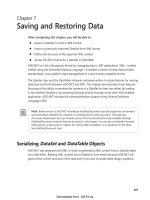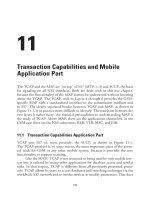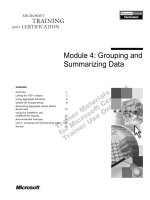wireless and mobile data
Bạn đang xem bản rút gọn của tài liệu. Xem và tải ngay bản đầy đủ của tài liệu tại đây (444.4 KB, 14 trang )
1
Ch. 14 - Wireless and Mobile Data
Characteristics
1 Wireless vs Mobile
2 Wireless Characteristics
3 Generic Wireless Network
4 Micro- and Macro Mobility
5 Mobile IP
6 Connectivity
7 Packet Switched vs Circuit Switched
8 Wireless Data Communications Systems
9 Wireless LAN and MAN
10 Mobility and Bitrate map
Ch. 14 - Wireless and Mobile Data Characteristics
2
Many people use the terms wireless and mobile as synonyms. This is not strictly true. In
this table we try to illustrate the differences between the terms wireless and mobile.
Those users that are not wireless and not mobile are easy to come up with. This is what you
can call "traditional data communications" and consists of conventional LAN, MAN and
WAN technology, such as ethernet, FDDI or X.25.
At the other extreme, there are users that are both wireless and mobile. So here we can have
taxis using radio modems, field service engineers (recall that Mobitex's first application was
for Telia's field service engineers), transport and public safety users.
What about the users that are using wireless technology but are not mobile? These are the
traditional "telemetry" applications that were mentioned in chapter 13. These include
parking or gas meters and coke machines.
The last set of users, those that are mobile but not wireless are a little harder to define.
Imagine the following scenario, I sit in my office in Gothenburg and work on my laptop PC
connected to my local network. Then I pick up my laptop, jump on a plane and fly to
Stockholm. There I plug my PC into the LAN in Stockholm and carry on working as if I was
on my home network. In this case I'm using wired technology - the two Local Area
Networks, but in some sense I'm mobile because I move around the country. This type
of access is called Nomadic Computing. An example of technology that allows this kind of
movement is Mobile IP, which will be explained in more detail later.
Ch. 14 - Wireless and Mobile Data Characteristics
3
Because wireless data uses an unguided medium it suffers from certain problems that do not
affect its wired counterpart. One must remember that a wireless user is constrained by the
network coverage. If the user moves to an area without coverage, then the user's
terminal becomes useless. Although network operators try to minimize these "blackspots"
they are inevitable, especially for new networks that are in the process of being deployed.
Multi-path fading, log-normal fading, inter-symbol interference and attenuation are all
characteristics of the radio medium. Coupled with the limited amount of frequency spectrum
available to wireless applications these attributes mean that the raw bit error rate is greater
than that found in guided mediums. This means that greater overheads are required to
maintain acceptable error rates, thus reducing the amount of user data that can be sent per
second.
So, wireless systems almost always offer lower bit rates than their wired alternatives.
Wireless systems also tend to have a higher latency than wired systems. For most protocols
this is not a big issue, but is something that should be addressed when setting protocol
parameters (e.g., timeouts should generally be longer due to the slower response times).
Ch. 14 - Wireless and Mobile Data Characteristics
4
Although all wireless networks are different they do share some common characteristics.
Here we try and illustrate those parts, which most systems share.
Most wireless applications consist of a user wishing to communicate with a server at some
remote location. The user's terminal is connected to the wireless network via a radio link to a
base station. The server is connected to a network, be it the Internet or some corporate
Intranet. Now, each base station is connected to something called a serving node. The
terminology differs depending on which mobile network you look at, but the idea is almost
always the same. Note that one serving node can be attached to several base stations. On the
other side of the diagram we have the network attached to some gateway. Finally, tying the
pieces together we have the backbone network to which both the gateway and the serving
node are connected. Note that the backbone can be connected to several serving nodes and
several gateways. Using this network a wireless user can communicate with a remote server.
Other things are also attached to the network backbone. For example, there is some kind of
subscription register to store information on the mobile users. There is also some operations
and maintenance equipment to allow network monitoring, charging etc.
Ch. 14 - Wireless and Mobile Data Characteristics
5
Micro and macro mobility are terms used to describe different methods of dealing with
mobility management. Micro mobility techniques are used when mobiles move between
individual base stations - micro means small and so micro mobility techniques are used for
small moves.
Macro means big, so macro mobility techniques are used for large moves between different
networks. So, for example, when you take your GSM telephone from your home network in
Sweden, and move to a new network in a different country, for example in England, you are
moving to a new network and therefore the mobility management is solved using macro
mobility techniques.
Now, you may have spotted there is a grey area in this definition. If micro mobility is
moving between base stations and macro mobility is moving between networks, what term
do we use for moving between different serving nodes?
There is no right and wrong answer here; it depends on the techniques implemented in the
network. For example, in a GSM network the same techniques are used when mobiles move
between base stations and between serving nodes. So, GSM solves the problem of moving
between serving nodes with micro mobility techniques. Conversely, PDC, the Japanese
mobile telephone standard, uses macro mobility techniques for mobiles moving between
serving nodes, so moving from one serving node to another and moving from one network to
another both use the same technique. It's simply a question of how the network is
standardized.
Ch. 14 - Wireless and Mobile Data Characteristics
6
What is Mobile IP? Well, it's a macro mobility technique that is it can be used to allow
movement between two interconnected networks. In this example we are using Mobile IP to
allow a portable user to move between two different LANs interconnected by the Internet.
Imagine this scenario. You normally work in you lovely air-conditioned office in Dallas. One
day your boss informs you that you have to go to Ericsson Stockholm to give a
presentation. You spend a few hours preparing the presentation, which remains on a
server on your home network. You then take your lap top computer across the Atlantic to
your meeting in Stockholm. There you plug in to the LAN. Without having to change any
configuration parameters or addresses, you can immediately access your home LAN in
Dallas and can easily give your presentation. Also, external users can still contact you with
your original IP address, as that has moved with you. This transparent mobility is the job of
Mobile IP.
So, how does it work? Well, conceptually it's quite simple. Here you can see your home
network in Dallas and your foreign network in Stockholm. When you are on your home
network you are addressed using the IP address 193.234.210.74. Users on your own
network or on other networks connected to the Internet can talk to your computer using that
IP address, 193.234.210.74. The router on your home network ensures that packets bearing
your IP address are delivered to you.
Now, what happens when you pick up your laptop, spend 10 hours on a plane and arrive at
Ericsson in Stockholm? Well, when you plug your laptop into this new foreign network
your laptop talks to the router on the foreign network, which is called the Foreign Agent.
Ch. 14 - Wireless and Mobile Data Characteristics
7
Your laptop basically sends a message to the Foreign Agent saying, "Hi, I'm laptop
193.234.210.74 and I'd like to use your network." The Foreign Agent then sends a message
to the router on the home network, the Home Agent, and says "The mobile with IP
address 193.234.210.74 isn't on your network anymore, but it can be reached by sending
packets to me at IP address 193.17.213.64." The Home Agent accepts this request and then
we're ready to roll.
So, what happens when some host out on the Internet starts to send packets to your
laptop? Well, the routers on the Internet have no knowledge of your boss's decision to send
you to Stockholm, so they forward the packets to your home network as usual. The router
on your home network, the Home Agent, sees these packets and remembers the care-of-
address it received from the Foreign Agent. So, it takes your IP packets and sends them
through an IP tunnel over the Internet to the Foreign Agent. The Foreign Agent looks at the
packets and thinks, "This IP address isn't on my network, but I remember receiving
information about it, so I can forward it on directly." In this way packets reach the mobile
node.
What happens when the mobile node wishes to send packets out to the Internet? Well, this
causes no problem whatsoever, the laptop builds IP packets with the desired destination
address and the usual source address (that is, 193.234.210.74) and sends them directly out to
the Internet as usual.
Of course Mobile IP isn't perfect. One of the biggest drawbacks is the routing inefficiency it
introduces. Packets destined for our laptop pass through the Internet to our home network
and then back out onto the Internet to our foreign network. This doglegged routing means
that received packets suffer from higher latency than normal. It also means that the Internet
is loaded more as the same packets must pass through it twice. There are also some
important security implications to consider with Mobile IP. The mobile node must
be carefully verified to ensure that packets are not forwarded to impostors intent on stealing
others information.
Mobile IP is only one of a host of macro mobility techniques. Others, such as Dynamic
DNS, L2TP and IP security are also capable of solving the problem of nodes moving
between interconnected networks.
Ch. 14 - Wireless and Mobile Data Characteristics
8
In most cases a mobile node wishes to talk to some remote computer. For users and
applications, the way these computers communicate doesn't matter that much. Using a wired
or wireless network makes no difference as long as the packets arrive. This is why these
industry standard protocols, such as TCP and IP, are used. If the applications see some
standard interface then they don't need to know if they are using a wireless network or a
fixed network, they just see a standard interface. These standard interfaces are extremely
important to both application and network designers.
Ch. 14 - Wireless and Mobile Data Characteristics
9
It is extremely important to understand the difference between packet switched and circuit
switched systems, a difference, which is illustrated here.
You can compare a circuit switched data to a train and the physical medium is the train line.
Before the train (data) can use the line it has to ask and be granted access. Once this is done
the train can then proceed on the line, but it has exclusive access to the line. No other trains
can use the line while our train is there. In a data communications environment,
circuit switchings main drawbacks are the call setup overhead (that is, asking for and being
granted access to the line) and the low utilization of the physical medium (only one train at a
time). One advantage of circuit switching is that the call setup procedure allows users to
be allocated and guaranteed a certain bandwidth. A good example of circuit switching is the
analogue telephone network. Before you can talk to anyone you have to dial their number (a
call request). The call is physically switched through the network until you had an end-to-
end circuit between your telephone and the telephone you are calling. Only when the phone
is answered at the other end (a call accept) can communication begin.
What about packet switching? Well, in this case our data can be imagined as cars and the
physical medium as a motorway.
Instead of sending one big chunk of data, like we did with a circuit switched train, we send
smaller chunks of data, with many users on the same channel simultaneously. The advantage
with this is that we don't need any call set-up procedure, we just jump in the car and go.
Packet switching also gives a much higher channel utilization, because many people can use
the same motorway simultaneously.
Ch. 14 - Wireless and Mobile Data Characteristics
10
The disadvantage is that because we have no way of knowing how much data other users are
going to send there is no guarantee of bandwidth if too many people try to use the
motorway at the same time it will slow down and eventually stop. The best example of a
packet switched network is the global Internet.
Ch. 14 - Wireless and Mobile Data Characteristics
11
There are lots of different wireless data communication systems. To help us understand
them all we divide them into different categories, Local Area Networks, Metropolitan Area
Networks and Wide Area Networks. Some of the techniques used for wireless LANs and
MANs are shown here, but we'll discuss those in a little more detail in the next slide.
Wide Area Networks have been divided up into two distinct groups here circuit switched
and packet switched. On the circuit switched side are Satellite phones, the American mobile
telephone standard AMPS, GSM and PDC. HSCSD is a new data oriented circuit switched
service for GSM, which will be discussed a little more in chapter 16.
The oldest of the packet switched services is Mobitex; a dedicated packet switched network
that has been available since 1986.
The other three systems are conceptually very similar, they all build on existing circuit
switched mobile telephony infrastructures and they all add a packet switched service. GPRS
provides packet data services by building on the GSM infrastructure, PPDC provides packet
data services by building on PDC and CDPD provides packet data services by building on
the AMPS system.
Ch. 14 - Wireless and Mobile Data Characteristics
12
In the wireless LAN marketplace there are two main solutions, using infra-red or radio
waves. None of these solutions pretends to offer mobility - they merely offer a slightly more
flexible way of coupling your desktop computer to the LAN. In some cases this
wireless flexibility can be very desirable - laptop users do not need to continually plug and
unplug network cables, they can simply move into the covered area and start working. In
some older buildings, pulling cable to every desktop can be expensive, so using a wireless
solution can save money. Of course, the usual drawbacks apply - the bit rate is much lower
than that offered by other LAN technologies. Typically IR and RF based LANs offer a bit
rate of about 4 Mbps. Compared with Ethernet, which is over 25 years old and yet manages
10 Mbps, that can be a considerable drawback. IR based nets are also further limited by the
fact that their connections must be "line-of-sight" based. This is not a problem for RF based
LANs.
An interesting solution to the MAN question has been developed by an American company
called Metricom. They've developed a wireless system that breaks away from the usual
wireless network topology that we saw in chapter 14.3. Instead of building a hierarchical
system consisting of base stations, serving nodes and a backbone, Metricom build a semi-
intelligent mesh consisting of small boxes that sit on top of street light and utility poles. One
or more of these pole top boxes is equipped with a fixed connection to the global Internet.
When a user sends data it goes to the nearest pole top box. This box then independently
routes the information to a box that has a fixed connection. All this routing is done
automatically by the meshed network, there is no human intervention and no need for
hand crafted routing tables.
Ch. 14 - Wireless and Mobile Data Characteristics
13
Metricom's system currently offers a bit rate of 38 kbps, a speed they hope to increase to
56 kbps some time in 1999.
They offer a public Internet access service in three American urban areas, the Bay Area
in California, Seattle and Washington DC. Metricom's solution is also being used by several
campus based networks and by Sun Microsystems (among others) to cover their corporate
campus. The system uses the license free portion of the RF spectrum and utilizes a
patented frequency hopping technique to provide security and maintain good link quality.
The pole top boxes are positioned every 400 to 800 meters and take approximately 5
minutes to install. Metricom believe that their system has almost unlimited scalability, and
could cover the whole of the states if necessary.
Ch. 14 - Wireless and Mobile Data Characteristics
14
This diagram allows you to compare the systems we've mentioned in this lesson. The
horizontal-axis uses a logarithmic scale to show the bit rate a system offers. The vertical-axis
shows the amount of coverage a system offers, from a single room to the whole world.
As you can see, those systems with the lowest mobility, the wireless LAN solutions, offer
the highest bit rates, whilst those with higher mobility, such as GSM, offer lower bit rates.
The red lines indicate the future developments. For example, GSM currently offers coverage
spanning the globe and a bit rate of 9.6kbps. Enhancements, such as GPRS and HSCSD will
increase this bit rate.
AMPS offers coverage in several countries across the world with a bit rate similar to that
found in GSM. Future enhancements, such as circuit switched data, will offer higher bit rates
than are currently available. Metricom's system, which was discussed earlier offers a higher
bit rate than current GSM or AMPS systems, but only provides mobility at the
metropolitan level.
Universal Mobile Telecommunications System, UMTS, will offer a much higher bit rate than
any of today’s systems. Because of the expense of introducing mobile networks, the first
implementations will offer patchy coverage. As time progresses, hopes are that UMTS
will cover the globe.









